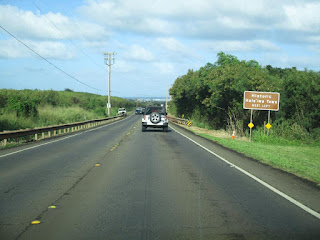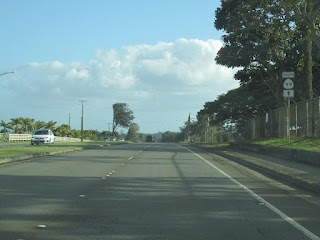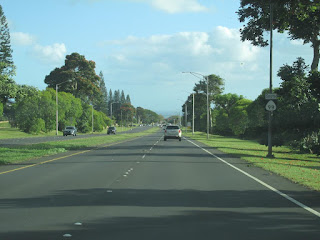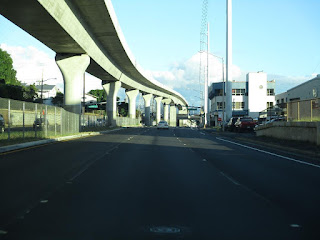Hawaii Route 99 is a 23.84-mile State Highway located on the Island of Oahu. Hawaii Route 99 begins near Joint Base Pearl Harbor-Hickam at Interstate H-1 and largely follows the Kamehameha Highway north to Hawaii Route 83/Hawaii Route 930 in Haleiwa. Hawaii Route 99 is also comprised as part of the Farrington Highway, Wilikina Drive and Kamananui Road.
This page is part of the Gribblenation Oahu Highways page. All Gribblenation and Roadwaywiz media related to the highway system of Oahu can be found at the link below:
https://www.gribblenation.org/p/gribblenation-oahu-highways-page.html
Part 1; the history of Hawaii Route 99
Prior to the Statehood the first signed highways within Hawaii Territory came into existence during World War II. During World War II the territory of Hawaii saw an influx of military activity following the attack on Pearl Harbor on December 7th, 1941. Numerous Military Routes and early Hawaii Routes were signed through the Hawaiian Territory to aid military personnel in navigating the islands. Military Highways were assigned US Route style shields whereas lesser highways were assigned an early variation of what is now the Hawaii Route Spade.
A 1946 Army Map of the Island of Oahu shows the future current corridor of Hawaii Route 99 as part of Military Route 1 on Kamehameha Highway from Hickam Air Force Base to Wahiawa via Ewa Junction, Military Route 3 on Wilikina Drive, Military Route 17 on Kamananui Road and Military Route 12 on Kamehameha Highway to the outskirts of Haleiwa. A full version of the 1946 Army Map of Oahu can be seen on hawaiihighways.com here.
Circa 1955 following the conclusion of World War II the United States Bureau of Public Roads renumbered the Hawaii Route System. The 1955 Hawaii Route Renumbering saw most of the conventions utilized by the current Hawaii State Route System established. Primary Hawaii Routes were given two-digit numbers whereas Secondary Hawaii Routes were given three-digit numbers. The Hawaii Routes were assigned in sequence for what Island/County they were located on coupled with what Federal Aid Program number they were tied to. In the case of Oahu the Island was assigned numbers in the range of 60-99.
Hawaii Route 99 was a new routing beginning at Ewa Junction northwest to Kaena Point. Hawaii Route 99 was aligned on Kamehameha Highway from Ewa Junction to Wahiawa, Wilikina Drive, Kaukonahua Road and Farrington Highway to Kaena Point. In the case of Hawaii Route 99 to Kaena Point it was aligned directly over the grade of the Oahu Railway which went defunct during 1947. The initial alignment of Hawaii Route 99 can be seen on the 1959 Gousha Highway Map of Hawaii.
On August 21st, 1959, Hawaii became the 50th State which saw its profile rise significantly. The Interstate System in Hawaii was authorized as part of the 1960 Statehood Act. The 1960 Statehood Act authorized Interstates H-1, H-2 and H-3 on the Island of Oahu. The building of the Interstate System on Oahu would greatly affect numerous Hawaii Route corridors including that of Hawaii Route 99.
Much of the corridor of Interstate H-1 east of downtown Honolulu was inherited from Hawaii Route 72 and the existing Mauka Lateral. Hawaiihighways.com details the construction history of Interstate H-1 on their Oahu page. The first segment of the Lunalilo Freeway to be constructed as Interstate H-1 between Exit 25B east to 26A was completed by 1965. This segment can be seen under construction in the 1965 Hawaii Department of Transportation photo below.
Unlike the other Interstate corridors of Oahu Interstate H-2 was relatively uncontroversial and three general routing options were discussed via public hearing during October 1962. Construction of the Wahiawa Interchange would begin during 1971. The first two northbound miles of Interstate H-2 opened to traffic from Interstate H-1 to Mililani Cemetery on October 3rd, 1974. The opening ribbon cutting ceremony of the first two miles of Interstate H-2 can be seen in the October 4th, 1974 Honolulu Advisor.
The construction of Interstate H-1 and Interstate H-2 led to a realignment of Hawaii Route 99. The 1983 USGS Maps of Oahu show Hawaii Route 99 with substantial changes. Hawaii Route 99 is shown originating at Interstate H-1 near Hickam Village and following Kamehameha Highway north to the vicinity of what was Ewa Junction over what had been Hawaii Route 90. Approaching Ewa Junction the Kamehameha Highway had been obliterated by the construction of Interstate H-1 and Interstate H-2. Hawaii Route 99 followed a short jog via Farrington Highway to reach the next segment of Kamehameha Highway.
From Ewa Junction Hawaii Route 99 followed its original corridor via Kamehameha Highway north to Wahiawa. Hawaii Route 99 followed its alignment Wilikina Drive but split onto Kamananui Road over what had been Hawaii Route 82 back to Kamehameha Highway.
North of Wahiawa Hawaii Route 99 was realigned on Kamehameha Highway over what had been Hawaii Route 82 to Hawaii Route 83/Hawaii Route 930 in Haleiwa.
Hawaii Route 99 northbound initially begins on Kamehameha Highway which follows the eastern shore of Pearl Harbor. The incomplete Honolulu Rail Transit can be seen along Hawaii Route 99/Kamehameha Highway in the vicinity of Pearl Harbor.
Hawaii Route 99/Kamehameha Highway northbound serves as primary access to Pearl Harbor National Memorial and the Ford Island Bridge. North of the Ford Island Bridge a junction gantry on Hawaii Route 99/Kamehameha Highway displays Hawaii Route 78 which was the previous designation of what is now Interstate H-201. Hawaii Route 99/Kamehameha Highway northbound splits left from a junction with Interstate H-201.





















































































Comments